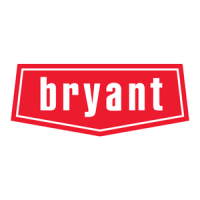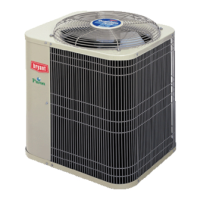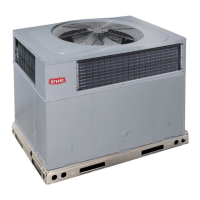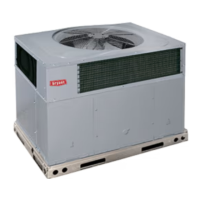
Do you have a question about the Bryant 661C and is the answer not in the manual?
| Model | 661C |
|---|---|
| Type | Heat Pump |
| SEER Rating | 16 |
| HSPF Rating | 9.0 |
| Refrigerant | R-410A |
| Stages | 1 |
| Voltage | 208/230V |
| Compressor Type | Single Stage |
| Warranty | 10-year parts limited warranty upon registration |
Explains signal words DANGER, WARNING, CAUTION and the safety-alert symbol for injury awareness.
Warning about ensuring the main electrical disconnect switch is OFF before servicing to prevent shock.
Recommendations for unit placement and refrigerant tubing routing to minimize noise and vibration.
Unpack unit, inspect equipment, and check rating plate for job specifications.
Ensure the unit is installed on a solid, level mounting pad, within ± 2° tolerance.
Maintain adequate space for airflow, wiring, piping, and service access around the unit.
Specifies minimum and maximum outdoor operating ambients for cooling and heating modes.
Elevate unit for proper drainage in areas prone to freezing temperatures or snowfall.
Verify indoor coil piston matches outdoor unit rating plate; replace if mismatch occurs.
Ensure defrost thermostat is correctly located and securely attached to the feeder tube stub.
Connect refrigerant tubing to service valves, use brazing shield, and perform leak testing.
Connect ground, power, and control wiring per NEC and unit specifications, checking all terminations.
Power the crankcase heater 24 hours before starting if refrigerant tubing exceeds 50 ft.
Follow instructions provided with kits or accessories for proper installation.
Procedures for starting the unit, with cautions against overcharging, vacuum, or disabling safety switches.
Explains the defrost control, its time/temperature settings, and sequence of operation.
Describes the cooling cycle sequence, detailing thermostat calls and component activation.
How to check refrigerant charge in cooling and heating modes using charts and unit rating plates.
Importance of periodic maintenance for continued high performance and minimizing equipment failure.












